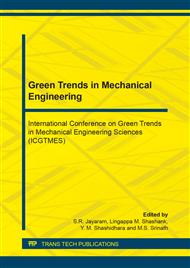[1]
N.A. Peppas, Handbook of biomaterial properties, J. Control. Release. (2000).
Google Scholar
[2]
M. Niinomi, M. Nakai, Titanium-based biomaterials for preventing stress shielding between implant devices and bone, Int. J. Biomater. (2011).
DOI: 10.1155/2011/836587
Google Scholar
[3]
R.B. Ruben, P.R. Fernandes, J. Folgado, On the optimal shape of hip implants, J. Biomech. (2012).
Google Scholar
[4]
G. Ryan, A. Pandit, D.P. Apatsidis, Fabrication methods of porous metals for use in orthopaedic applications, Biomaterials. (2006) 2651–2670.
DOI: 10.1016/j.biomaterials.2005.12.002
Google Scholar
[5]
T. Tsutsui, Recent Technology of Powder Metallurgy and Applications, (2012).
Google Scholar
[6]
C.W. Corti, Sintering Aids in Powder Metallurgy, Platin. Met. Rev. (1986).
Google Scholar
[7]
R. Raman Mishra, A. Sharma, Microwave Sintering of Pure Metal Powders – A Review, Int. J. Adv. Mech. Eng. 4 (2014) 2250–3234.
Google Scholar
[8]
S. Ramakrishna, J. Mayer, E. Wintermantel, K.W. Leong, Biomedical applications of polymer-composite materials: A review, Compos. Sci. Technol. 61 (2001) 1189–1224.
DOI: 10.1016/s0266-3538(00)00241-4
Google Scholar
[9]
G.O. Hofmann, Biodegradable implants in orthopaedic surgery-A review on the state-of-the-art, Clin. Mater. (1992).
Google Scholar
[10]
L.E. Murr, S.M. Gaytan, E. Martinez, F. Medina, R.B. Wicker, Next generation orthopaedic implants by additive manufacturing using electron beam melting, Int. J. Biomater. (2012).
DOI: 10.1155/2012/245727
Google Scholar
[11]
R. Huiskes, H. Weinans, B. VAN Rietbergen, The Relationship Between Stress Shielding and Bone Resorption Around Total Hip Stems and the Effects of Flexible Materials, Clin. Orthop. Relat. Res. (1992).
DOI: 10.1097/00003086-199201000-00014
Google Scholar
[12]
J.E. Lemons, L.C. Lucas, Properties of biomaterials, J. Arthroplasty. 1 (1986) 143–147.
Google Scholar
[13]
T. Kokubo, Bioceramics and their Clinical Applications, (2008).
Google Scholar
[14]
Q. Wu, X. Zhang, B. Wu, W. Huang, Effects of microwave sintering on the properties of porous hydroxyapatite scaffolds, Ceram. Int. 39 (2013) 2389–2395.
DOI: 10.1016/j.ceramint.2012.08.091
Google Scholar
[15]
P. Dahl, I. Kaus, Z. Zhao, M. Johnsson, M. Nygren, K. Wiik, T. Grande, M.A. Einarsrud, Densification and properties of zirconia prepared by three different sintering techniques, Ceram. Int. 33 (2007) 1603–1610.
DOI: 10.1016/j.ceramint.2006.07.005
Google Scholar
[16]
Y. Hosni, O. Harrysson, Design and Manufacturing of Customized Implants, 53 (2012) 564–569.
Google Scholar
[17]
M. Das, V.K. Balla, T.S.S. Kumar, I. Manna, Fabrication of Biomedical Implants using Laser Engineered Net Shaping (LENSTM), Trans. Indian Ceram. Soc. 72 (2013) 169–174.
DOI: 10.1080/0371750x.2013.851619
Google Scholar
[18]
Z.Z. Fang, Sintering of advanced materials, (2010).
Google Scholar
[19]
M. Oghbaei, O. Mirzaee, Microwave versus conventional sintering: A review of fundamentals, advantages and applications, J. Alloys Compd. 494 (2010) 175–189.
DOI: 10.1016/j.jallcom.2010.01.068
Google Scholar
[20]
E. Champion, Sintering of calcium phosphate bioceramics, Acta Biomater. (2013).
Google Scholar
[21]
J. Liu, H. Yan, M.J. Reece, K. Jiang, Toughening of zirconia/alumina composites by the addition of graphene platelets, J. Eur. Ceram. Soc. 32 (2012) 4185–4193.
DOI: 10.1016/j.jeurceramsoc.2012.07.007
Google Scholar
[22]
R.R. Mishra, A.K. Sharma, Microwave-material interaction phenomena: Heating mechanisms, challenges and opportunities in material processing, Compos. Part A Appl. Sci. Manuf. 81 (2016) 78–97.
DOI: 10.1016/j.compositesa.2015.10.035
Google Scholar
[23]
A.K. Sharma, R.R. Mishra, Role of particle size in microwave processing of metallic material systems, Mater. Sci. Technol. 0836 (2017) 1–15.
Google Scholar
[24]
D.K. Agrawal, Microwave processing of ceramics, Curr. Opin. Solid State Mater. Sci. (1998).
Google Scholar
[25]
D. Agrawal, Microwave sintering of ceramics, composites and metallic materials, and melting of glasses, Trans. Indian Ceram. Soc. 65 (2006) 129–144.
DOI: 10.1080/0371750x.2006.11012292
Google Scholar
[26]
A. Barba, C. Clausell, C. Felíu, M. Monzó, Sintering of (Cu0.25Ni0.25Zn0.50)Fe2O4 Ferrite, J. Am. Ceram. Soc. 87 (2004) 571–577.
Google Scholar


